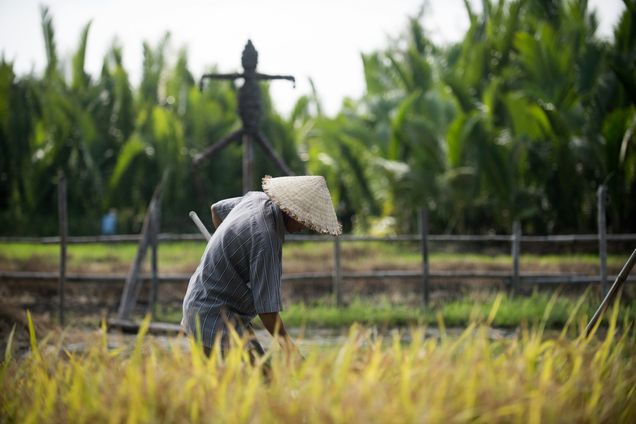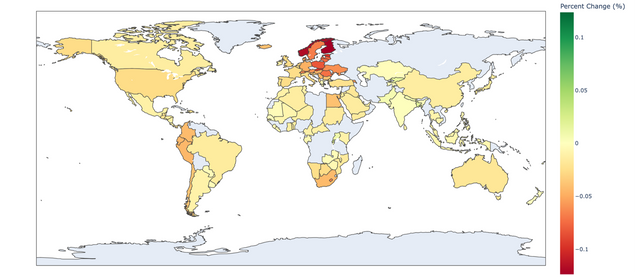Summer in the Field: How Does Climate Change Affect Economic Productivity? A Global Perspective from 2000-2017

By Ericka Osses
Climate change poses significant risks to the global economy by affecting labor productivity, influencing investment decisions and adding uncertainty to long-term planning. During my time as a 2025 Summer in the Field Fellow, I quantified the macroeconomic consequences of climate change across countries by working in the computer lab at Boston University.
Building on this work, I added climate variables to an economic model. This interdisciplinary approach helps with understanding climate challenges and generates empirical evidence that can support more sustainable economic planning. In addition, this analysis formed the basis of Chapter 2 of my doctoral dissertation.
To explore the relationship between climate and productivity, it is important to understand how economic productivity is traditionally measured and what drives it. Burke et al. (2015) argue that economic output can be simulated by a production function that represents two factors:
- Capital, the set of goods and infrastructure (machinery, buildings, technology) that are used to produce other goods and services.
- Labor, referring to human effort (both physical and mental) dedicated to production.
I expand the traditional two-factor production function by including ecosystem services, which are benefits provided by natural ecosystems that support economic activity, such as agricultural productivity, tourism and climate regulation.
Climate change may affect labor, capital and ecosystem services. To investigate each, I have compiled observations for economic output, as measured by gross domestic product (GDP), in millions of constant US dollars; capital, measured in millions of US dollars; labor, measured in millions of people; and gross primary production (GPP), measured in kilograms of carbon per square meter per year for 114 countries between 2000 and 2017.
First, I investigate the effect of temperature on the productivity of capital and labor by estimating four specifications for a production function: a base case in which the raw measures of labor and capital appear on the right-hand side and three alternative specifications, in which labor per capita is (1) divided by temperature, (2) divided by temperature squared and (3) divided by the log of temperature. I compare the out-of-sample forecasts generated by each of the three alternative specifications to the base case using a test of accuracy.
The results indicate that the specification that divides labor by temperature increases accuracy relative to the base case, which suggests that higher temperatures reduce labor productivity. Conversely, none of the alternative specifications for capital increase accuracy relative to the base case, which suggests that higher temperatures do not reduce the productivity of capital.
These results suggest that labor is more sensitive to rising temperatures than capital. Put simply, human work is more affected by heat than machines, infrastructure or technology. This may be because people are directly exposed to environmental conditions and their performance declines under extreme heat.
In a second step, I isolate the effect of changes in temperature and gross primary productivity on GDP. To do so, I simulate the model using three scenarios:
- Labor productivity scenario in which temperature changes as observed, but GPP is held at the sample mean for each nation;
- Ecosystem services scenario in which temperature is held at its sample mean for each nation and GPP changes as observed;
- Combined scenario in which both temperature and GPP change as observed.
Each of these scenarios is compared to a base case in which temperature and GPP is held at its sample mean. I compute the average percent difference between the base case at each of the three scenarios.
The Labor Productivity Scenario (Figure 1) indicates that a higher temperature generally reduces GDP. Finland, Norway and Estonia suffer the greatest losses while Rwanda, India and New Zealand enjoy small gains.
Figure 1: Labor Productivity Model

The Ecosystem Services Scenario (Figure 2) indicates that the effects of changes in GPP vary among nations. GPP generally declines at low latitudes, which reduces GDP, while GPP increases at higher latitudes.
Figure 2: Ecosystem Services Model

Lastly, the Combined Scenario (Figure 3) indicates that climate change tends to increase economic activity slightly in developed countries while climate change tends to reduce economic activity in developing nations. For instance, Canada, Norway and Qatar show mild gains, whereas Sudan, Kazakhstan and Ukraine experience losses.
Figure 3: Combined Model

Together, these results suggest that climate change affects the global economy via labor productivity and ecosystem services. Understanding these dynamics is essential for designing policies that promote more equitable and sustainable modes of economic development in a changing climate. By integrating temperature and ecological productivity into economic analysis, we can move toward a more comprehensive view of growth and resilience—one in which financial stability and human well-being depend on the health of our planet.
Finally, it is important to emphasize that these are preliminary results. In ongoing research, I will forecast how changes in climate may affect economic activity through 2100. Through this ongoing research, I aim to contribute to a deeper understanding of how climate change affects our economies and what actions we can take today to build a more just, resilient and sustainable future.
*
Learn more about the Summer in the Field Fellowship Program.